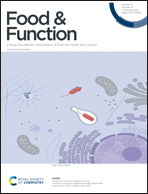Glucose metabolism enhancement by 10-hydroxy-2-decenoic acid via the PI3K/AKT signaling pathway in high-fat-diet/streptozotocin induced type 2 diabetic mice
Abstract
10-Hydroxy-2-decenoic acid (10-HDA) is a principal active ingredients of royal jelly. Several recent studies demonstrated that 10-HDA has potential anti-type 2 diabetes mellitus (T2DM) properties. To evaluate the anti-T2DM effect of 10-HDA and explore its underlying molecular mechanisms, we used high fat diet (HFD) combined with streptozotocin (STZ) injection to establish a diabetes model. Mice were randomly divided into four groups (8 mice per group): control group, 10-HDA group, T2DM group, and T2DM + 10-HDA group. The 10-HDA and T2DM + 10-HDA groups were administered intragastric 10-HDA (100 mg per kg body weight), while the control and T2DM groups were administered a vehicle, daily for 4 weeks. Our analysis indicated that there was no significant difference in body weight between T2DM + 10-HDA and control group mice (P > 0.05). Treatment with 10-HDA reduced fasting blood glucose and increased insulin levels in diabetic mice (P < 0.05), as well as increasing the area of pancreatic islets (P < 0.05), and alleviating vacuolar degeneration in the liver. Further, 10-HDA intervention increased superoxide dismutase, catalase, and glutathione peroxidase activities in diabetic mouse liver, alleviated lipid peroxidation, inhibited liver NF-κB nuclear translocation, decreased IL-6 and TNF-α content, and increased P-PI3K, P-AKT, and P-GSK3β protein levels (all P < 0.05). Fifteen potential biomarkers were screened by analysis of liver metabolomics data, of which hexadecanamide, stearamide, pentadecanoic acid, and fatty acid esters of hydroxy fatty acids (16:0/18:1) were highly abundant. In conclusion, 10-HDA has clear hypoglycemic effects on diabetic mice, through the PI3K/AKT/GSK3β signaling pathway.



 Please wait while we load your content...
Please wait while we load your content...